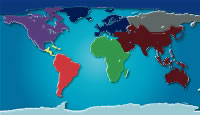International Organizations
Regions


EPA collaborates with a wide variety of multilateral organizations and through the United Nations and other multi-lateral programs to protect human health and the environment. As EPA seeks to manage emerging environmental threats and create successful partnerships to tackle old problems in new ways, these organizations and programs provide a forum for encouraging collective actions for common solutions. Working through multilateral organizations and programs allows EPA to leverage its resources and to respond quickly to emerging threats by offering a structured framework through which EPA can reach critical stakeholders. Examples of our multi-lateral collaborations include:
World Conservation Union
Invasive species are a cause of biodiversity loss. They also cause direct economic losses and management costs to commercial and recreational interests. EPA is working with the World Conservation Union to better identify and develop techniques that reduce or eliminate the risks of new introductions of invasive species into U.S. waters.
Asia-Pacific Partnership
EPA is working with Australia, China, India, Japan, Korea and the private sector through the Asia Pacific Partnership, launched in January 2006, to expand investment and trade in cleaner energy technologies, goods, and services in key market sectors. As part of this initiative, governments agreed to a that established eight public-private task forces: (1) cleaner use of fossil energy; (2) renewable energy and distributed generation; (3) power generation and transmission; (4) steel; (5) aluminum; (6) cement; (7) coal mining; and (8) buildings and appliances.
EPA has a leadership role for the U.S. in four task forces: clean fossil energy; cement; aluminum; and buildings & appliances. The agency is also actively involved in the work of several other task forces as well as in other cross-cutting areas under development, such as transportation. The six partner countries represent about half of the world's economy, population and energy use, and they produce about 65% of the world's coal, 48% of the world's steel, 35% of the world's aluminum, and 61% of the world's cement.
Working with international organizations provides EPA a forum for influencing the world community to take collective actions that contribute to common solutions. EPA leverages its resources through partnership and collaboration to efficiently achieve our environmental goals.
![[logo] US EPA](https://webarchive.library.unt.edu/eot2008/20081110233820im_/http://www.epa.gov/epafiles/images/logo_epaseal.gif)